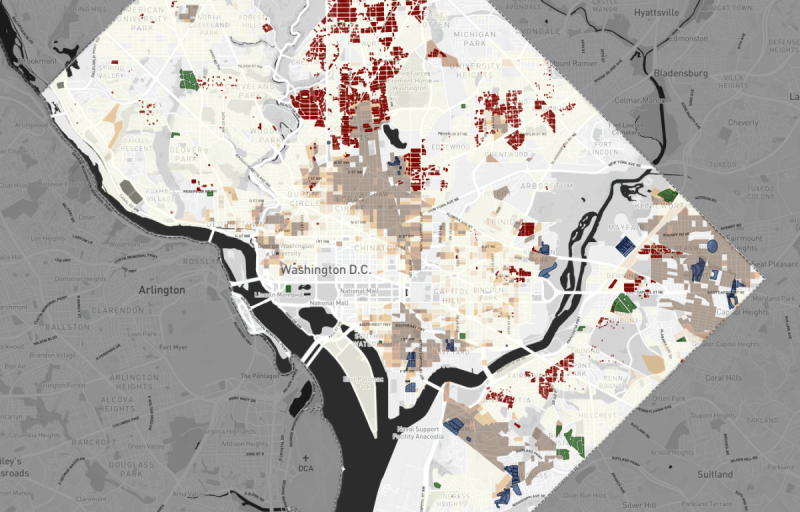These maps illustrate how public housing was manipulated to segregate DC

PrologueDC's new map illustrates public housing trends. Image by PrologueDC used with permission.
Since it was created mostly for white families during WWII, public housing has been used as a tool to segregate cities, and whites in power continued to use it for this purpose as more black residents moved in over the following decades. A recent map project from the historians at PrologueDC illustrates the ways public housing has been manipulated, and how it explains the patterns of segregation we see in DC to this day.
Across the District today, close to 20,000 residents live in public housing complexes owned by the DC Housing Authority. Since 2013, however, the waitlist has remained closed for prospective tenants, which held around 72,000 people at the time. The limited offerings of public housing in DC have a story, seeded in years of racially restrictive laws and inequality.
Currently, PrologueDC’s map chronicles the role public housing held in segregating the city from 1940 to 1970. The remaining years are set to be finished next summer, according to PrologueDC historian Sarah Shoenfeld.
WWII housing for whites and tools of segregation
Public housing first started to appear in the late 1930s, after Congress passed the National Housing Act in 1937. Public housing was first created for white communities as a way to provide temporary housing during World War II, Shoenfeld says.
“The area East of the [Anacostia] River was mostly white, so it’s not surprising that the housing developments for white people were built there in the 1940s,” Shoenfeld said.
For example, Ellen Wilson, white-only public housing built in 1941 near Capitol Hill, was used to keep African-Americans out the downtown area, according to Johanna Bockman, associate professor at George Mason University. All the black residents in the area were removed to build the complex, and none were allowed to move in when it was completed, effectively turning the mixed area all white.
“Public housing was originally intended to be segregated,” Bockman said. “It was intended by white people to get rid of large swaths of African-American housing on Capitol Hill. The intention of the very top organizers in DC was to create larger swathes of DC as a segregated, divided city.”
The period after the war ended, however, pushed the District into a time of racial transformation. As the public housing complexes had served their temporary purpose for the white working-class community, many had been torn down. The ones remaining, however, aided the transition to the segregated housing patterns that persist in DC today, according to Shoenfeld.
“For those that weren’t torn down, the racial transition of the city - the ability for white people to move out and corresponding inability for African-Americans to access better housing -facilitated the transition of all of public housing to become entirely black-occupied by the 1960s,” Shoenfeld said.
More public housing—and more racially-restrictive contracts
Throughout the same period that public housing grew, so did the usage of racially restrictive contracts, or deeds. Racially restrictive contracts were a legalized form of segregation that first started in the early 1900s.
Real estate developers shaped neighborhoods through their usage of the restrictive covenants, in areas such as Bloomingdale and what is now known as Ward 4, according to Shoenfeld.
“Much of that area East of the River was white communities developed as restricted in some cases,” Shoenfeld said. “In fact, the very first known use of restrictive covenants in the entire country was in a subdivision called Uniontown, which became Anacostia, in 1854. That was developed as a whites-only neighborhood to serve employees of the Navy Yard.”
Later on, white citizens associations also began adding those covenants to deeds where they didn’t already exist through “petition” restrictive covenants in areas such as Mount Pleasant, Brookland, and Petworth.
“What they did is sort of form barriers around existing black communities and prevented those communities from expanding,” Shoenfeld said.
In 1948, the enforcement of racially restrictive covenants became illegal through Shelley vs. Kraemer, but its legacy still lived on. Public housing complexes made for primarily African-Americans were created in black neighborhoods while white-only public housing on Capitol Hill reoccupied the somewhat mixed area, according to the PrologueDC website.
How does this relate to today?
During the 1970s, the federal government changed its ownership of public housing to public-private partnerships, according to Bockman’s article in the Journal of Urban Affairs. Historically, DC had always funded public housing with private bonds.
The federal government started HOPE VI in 1991 in an attempt to further redevelop public housing through public-private partnerships, according to Bockman.
“They were to basically demolish public housing and then to rebuild it anew where all the housing was supposed to look the same - and therefore, you couldn’t tell who was in public housing,” Bockman said. “They were supposed to be integrated and have mixed income”
Although the housing authority was required to integrate public housing in the 1950s, the act of redevelopment often ended up displacing residents and reshuffling power. In the decades after WWII, black residents moved into Ellen Wilson. Redevelopment plans for the building dismantled the existing community and ultimately recentered power in white hands, Bockman’s research shows.
“All the residents from Ellen Wilson dwellings were displaced, and that means that they no longer had a voice on what was going on, they were dispersed around the city,” Bockman said. “Therefore, the white housing residents right around the housing projects became the voice of the community, and they made the decision of what would happen. This was a particular block was on a racial dividing line. They wanted to reclaim the area for whites.”
